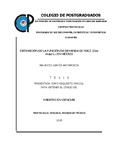| dc.contributor.author | García Matamoros, Mauricio | |
| dc.creator | GARCIA MATAMOROS, MAURICIO; 738045 | |
| dc.date.accessioned | 2019-05-07T19:53:31Z | |
| dc.date.available | 2019-05-07T19:53:31Z | |
| dc.date.issued | 2018-11 | |
| dc.identifier.uri | http://hdl.handle.net/10521/3155 | |
| dc.description | Tesis (Maestría en Ciencias, especialista en Economía).- Colegio de Postgraduados, 2018. | es_MX |
| dc.description.abstract | El maíz (Zea mays L.) es el cereal con mayor poder de trasformación y el producto agrícola más consumido en el mundo. En México tiene gran importancia social, cultural y económica, sus derivados son considerados como alimentos indispensables en la dieta diaria por su contenido y aportación de nutrientes, además, es el soporte del sector pecuario. La demanda ha crecido más que la producción, por lo que en los últimos años se ha presentado un incremento de las importaciones de maíz. El objetivo de este trabajo fue elaborar tres modelos de regresión lineal múltiple con datos anuales, para identificar las principales variables económicas que determinan la demanda de maíz grano en México y, analizar el efecto de cada variable sobre cantidad demandada. El primer modelo se realizó con datos de 1970 a 2015. En este, se analizó el comportamiento de la demanda de maíz grano en el país. En los modelos dos y tres se usaron datos de 1990 a 2015. Se analizaron por separado los determinantes de la demanda de maíz blanco y amarillo. Las variables independientes de los modelos se eligieron con base a la teoría económica y se validaron con base a las pruebas estadísticas de “t”, “f” y “r cuadrada”. Los resultados en el primer modelo indicaron que el maíz es un bien inelástico (-0.23), un bien normal necesario (0.24), un grano sustituto del trigo (0.28) y un complementario del sorgo (-0.31). En el segundo modelo el maíz blanco fue un bien inelástico (-0.61), un bien normal necesario (0.48), un sustituto del maíz amarillo (0.61) y un complementario del frijol (-0.21). En el tercer modelo el maíz amarillo es más elástico (-1.21) que el maíz blanco, tuvo una elasticidad ingreso de 1.41 y fue un sustituto de la soya (0.5). _______________ ESTIMATION OF THE CORN DEMAND FUNCTION (Zea mayz L.) IN MEXICO. ABSTRACT: Corn (Zea mays L.) is the cereal with the greatest transformation power and the most consumed agricultural product in the world. In Mexico it has great social, cultural and economic importance, its derivatives are considered as indispensable foods in the daily diet for its content and contribution of nutrients, also, it is the support of the livestock sector. Demand has grown more than production, so in recent years there has been an increase in corn imports. The objective of this research was to elaborate three models of multiple linear regression with annual data, to identify the main economic variables that determine the demand of grain corn in Mexico and to analyze the effect of each variable on quantity demanded. The first model was made with data from 1970 to 2015. In this, the behavior of the demand for grain corn in the country was analyzed. In models two and three, data from 1990 to 2015 were used. The determinants of demand for white and yellow corn were analyzed separately. The independent variables of the models were chosen based on economic theory and validated based on the statistical tests of “t”, “f” and “r square”. The results in the first model indicated that corn is an inelastic good (-0.23), a necessary normal good (0.24), a wheat substitute grain (0.28) and a sorghum complementary (-0.31). In the second model, white corn was an inelastic good (-0.61), a necessary normal good (0.48), a yellow corn substitute (0.61) and a bean complementary (-0.21). In the third model, yellow corn is more elastic (-1.21) than white corn, had an income elasticity of 1.41 and was a substitute for soy (0.5). | es_MX |
| dc.description.sponsorship | Consejo Nacional de Ciencia y Tecnología (CONACyT). | es_MX |
| dc.format | pdf | es_MX |
| dc.language.iso | spa | es_MX |
| dc.rights.uri | http://creativecommons.org/licenses/by-nc-nd/4.0 | es_MX |
| dc.subject | Maíz | es_MX |
| dc.subject | Demanda | es_MX |
| dc.subject | Elasticidades | es_MX |
| dc.subject | Corn | es_MX |
| dc.subject | Demand | es_MX |
| dc.subject | Elasticities | es_MX |
| dc.subject | Economía | es_MX |
| dc.subject | Maestría | es_MX |
| dc.subject.classification | CIENCIAS SOCIALES::CIENCIAS ECONÓMICAS::ECONOMÍA GENERAL::COMPORTAMIENTO DEL CONSUMIDOR | es_MX |
| dc.title | Estimación de la función de demanda de maíz (Zea mayz L.) en México. | es_MX |
| dc.type | Tesis | es_MX |
| Tesis.contributor.advisor | García Sánchez, Roberto Carlos | |
| Tesis.contributor.advisor | García Mata, Roberto | |
| Tesis.contributor.advisor | Sangermán Jarquín, Dora María | |
| Tesis.date.submitted | 2018 | |
| Tesis.date.accesioned | 2018 | |
| Tesis.date.available | 2018 | |
| Tesis.format.mimetype | pdf | es_MX |
| Tesis.format.extent | 1,378 KB | es_MX |
| Tesis.subject.nal | Elasticidad de la demanda | es_MX |
| Tesis.subject.nal | Demand elasticities | es_MX |
| Tesis.subject.nal | Demanda económica | es_MX |
| Tesis.subject.nal | Economic demand | es_MX |
| Tesis.subject.nal | Demanda del consumidor | es_MX |
| Tesis.subject.nal | Consumer demand | es_MX |
| Tesis.subject.nal | Valor nutritivo | es_MX |
| Tesis.subject.nal | Nutritive value | es_MX |
| Tesis.subject.nal | Importaciones | es_MX |
| Tesis.subject.nal | Imports | es_MX |
| Tesis.subject.nal | Exportaciones | es_MX |
| Tesis.subject.nal | Exports | es_MX |
| Tesis.subject.nal | México | es_MX |
| Tesis.rights | Acceso abierto | es_MX |
| Articulos.subject.classification | Maíz-aspectos económicos | es_MX |
| dc.type.conacyt | masterThesis | es_MX |
| dc.identificator | 5||53||5308||530802 | es_MX |
| dc.contributor.director | GARCIA SANCHEZ, ROBERTO CARLOS; 35450 | |
| dc.audience | generalPublic | es_MX |


